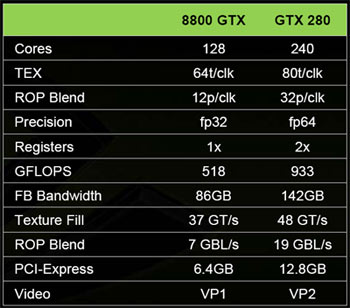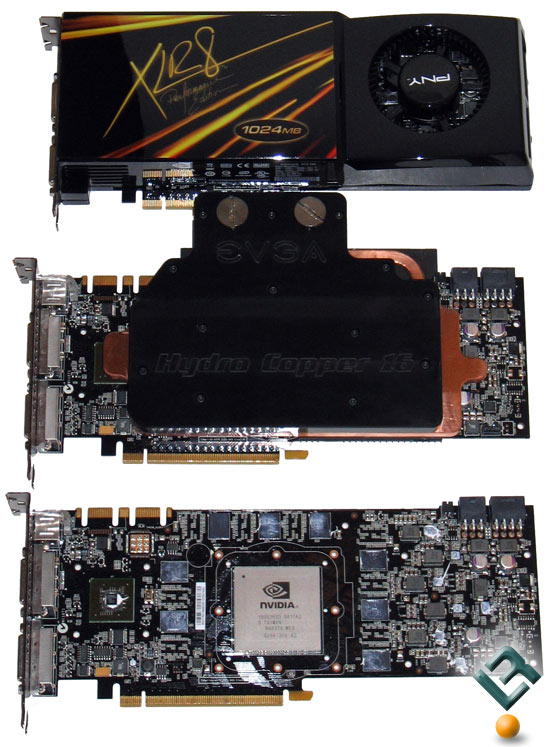NVIDIA GeForce GTX 280 Graphics Cards by EVGA and PNY
NVIDIA Brings The Muscle – GeForce GTX 280

When the NVIDIA GeForce 9 series of graphics cards launched back February 2008 with the GeForce 9600 GT leading the way, many enthusaists didn’t see the performance jump they were used to seeing and saw the series as a polished GeForce 8 GPU with a new name. The GeForce 9800 GX2 was launched in March 2008 and was the fastest card on the market, but wasn’t really innovative as it was again just a couple GeForce 8 series cores on a new board. By the time April 2008 came around the GeForce 9800 GTX it was yet another G92 based product and many enthusiasts were not impressed. Those that bought the GeForce 8800 GTX back in November 2006 had a card that was still faster in many applications and had no real reason to upgrade unless they wanted the new video processor or better power consumption numbers. Anyone that bought a GeForce 8800 GTX back in 2006 and paid an arm and a leg for it should pat themselves on the back as they bought a video card that lasted well into 2008. With that said, it is time for GeForce 8800 GTX owners to think about upgrading because after you read this you will be wanting to.

Since most consumers are not GPU experts lets compare the main features of the GeForce 8800 GTX from 2006 to the just released GeForce GTX 280. As you can see from the chart above the GeForce GTX 280 has 87.5% more cores (stream processors), double precision and huge increases in floating point bandwidth
This morning, NVIDA has announced the GeForce GTX 280 and GeForce GTX 260 graphics boards, which are part of the just announced GeForce GTX 200 GPU family and powered by the new GT200 GPU. These cards use NVIDIAs second-generation unified visual computing architecture and are more than just a polish of existing products. NVIDIA claims the GeForce GTX 280 will deliver an impressive 1.5x performance improvement on average over high-end GeForce 8 and GeForce 9 series single-GPU graphics boards, which makes it the fastest single-gpu board on they have ever produced. It has 240 processing cores and 1GB of GDDR3 frame buffer memory running on a wider 512-bit memory bus. The MSRP of one of these monseters is $649 for the stock-clocked GeForce GTX 280 video card.
If that is a bit too pricey, the crew over at NVIDIA have the $449 GeForce GTX 260. This card still has good price versus performance , but has a reduced number of processing cores (192 instead of 240) and lower frame buffer size (896MB instead of 1024MB). Today, we have a couple GeForce GTX 280’s to show you and they are two very different cards.

The EVGA GeForce GTX 280 Hydro Copper 16 is overclocked out of the box and uses water cooling to help keep things nice and cool. The PNY GeForce GTX 280 is based off the reference design and features reference clock speeds. What are the reference clock speeds you ask? The GTX 280 has 240 processors cores with a GPU clock speed of 602MHz, the stream processors run at 1296MHz and the 1GB of GDDR3 memory is clocked at 1107MHz. THe GeForce GTX 260 has 192 processor cores, a GPU clock speed of 576MHz, stream processors at 1242MHz and 896MB of GDDR3 memory at 999MHz. Both of the graphics cards are 10.5″ long and take up two slots on the motherboard.

Comments are closed.